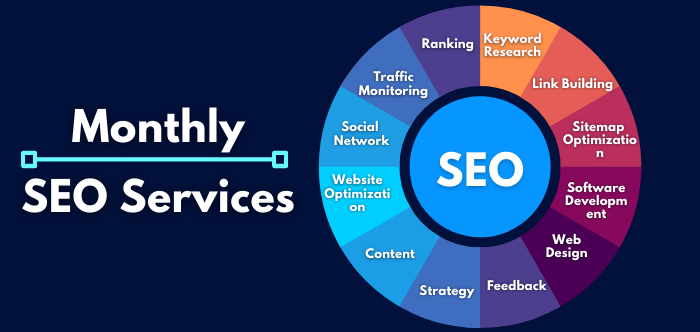Monthly SEO solutions refer to ongoing services provided by SEO (Search Engine Optimization) agencies or professionals to improve a website’s visibility and organic search rankings. These solutions typically involve a range of strategies and activities implemented on a monthly basis to optimize the website and attract more targeted traffic from search engines. Here’s an overview of the typical components you might find in monthly SEO solutions.
Initial Assessment and Keyword Research
The initial assessment and keyword research phase of SEO is a crucial step in understanding your website’s current status, identifying areas for improvement, and determining the most relevant keywords to target. Here’s an overview of what this phase typically involves:
- Website Analysis: SEO professionals conduct a thorough evaluation of your website to identify technical issues, on-page optimization gaps, and any other factors that may impact your search engine rankings. This analysis may include factors such as site speed, mobile-friendliness, URL structure, meta tags, internal linking, and user experience.
- Competitor Analysis: Understanding your competitors’ online presence is important. SEO experts analyze your top competitors to identify their strategies, strengths, weaknesses, and keywords they are targeting. This helps in developing a more effective SEO strategy for your website.
- Goal Identification: Clear goals are crucial for an effective SEO campaign. You’ll work with the SEO provider to define your objectives, whether it’s to increase organic traffic, improve search rankings for specific keywords, boost conversions, or enhance brand visibility.
- Target Audience Analysis: Understanding your target audience is essential for effective keyword research. SEO professionals will identify your ideal customer profiles, analyze their search behavior, preferences, and needs. This information helps in selecting keywords that align with your audience’s search intent.
- Keyword Research: Based on the information gathered from the previous steps, SEO experts perform keyword research to identify relevant search terms and phrases. This involves using various tools and techniques to discover keywords with high search volume, low competition, and strong relevance to your business. Long-tail keywords (specific and more extended search queries) may also be considered to capture targeted traffic.
- Keyword Selection: From the pool of identified keywords, SEO professionals prioritize and select the most relevant and valuable ones to target. They consider factors such as search volume, competition level, relevancy, and alignment with your goals and target audience.
- Keyword Mapping: After selecting target keywords, SEO experts map them to specific pages on your website. This involves assigning primary and secondary keywords to relevant pages based on their content and relevance. Proper keyword mapping helps search engines understand the context and relevance of each page.
- Reporting and Recommendations: Once the initial assessment and keyword research are complete, SEO professionals provide you with a report detailing their findings, recommendations, and a proposed SEO strategy. This report may include information on current website status, keyword rankings, competitor analysis, and suggested optimizations.
Remember, keyword research is an ongoing process, and it may need to be revisited periodically to adapt to changes in search trends, industry dynamics, and your business objectives. Regular monitoring and adjustment of targeted keywords help ensure the effectiveness of your SEO efforts.
On-Page Optimization
On-page optimization is a crucial aspect of SEO that focuses on optimizing various elements within your website to improve its visibility and relevance to search engines. These optimizations are performed directly on the web pages to enhance their ranking potential for specific keywords and improve user experience. Here are some key components of on-page optimization:
- Keyword Placement: Incorporate target keywords naturally within your page’s content, including headings, subheadings, and body text. Aim for a good keyword density without overstuffing, ensuring that the content remains readable and relevant to users.
- Meta Tags: Optimize meta tags, including the title tag and meta description. The title tag should be concise, compelling, and include the target keyword. The meta description should accurately summarize the page’s content and entice users to click through from search engine results pages.
- URL Structure: Create clean, descriptive, and keyword-rich URLs that accurately represent the content of each page. Avoid using lengthy or confusing URLs with unnecessary parameters.
- Heading Tags: Utilize heading tags (H1, H2, H3, etc.) to structure your content hierarchically. The H1 tag should contain the primary keyword and provide a clear headline for the page. Subheadings (H2, H3, etc.) can be used to organize the content and include relevant keywords where appropriate.
- Content Optimization: Ensure that your content is high-quality, relevant, and engaging. Optimize it by incorporating target keywords naturally throughout the content, using variations and synonyms where suitable. Aim to provide comprehensive information that addresses users’ queries and meets their needs.
- Internal Linking: Establish internal links within your website to provide a logical and structured navigation experience for users and search engines. Link relevant pages together using anchor text that includes keywords or descriptive phrases, helping search engines understand the relationships between different pages on your site.
- Image Optimization: Optimize images by using descriptive file names and alt tags that include relevant keywords. Compress images to reduce file size and improve page load speed, which can positively impact user experience and search rankings.
- Mobile-Friendliness: Ensure that your website is mobile-friendly and responsive, adapting to different screen sizes and devices. Mobile-friendliness is a crucial ranking factor, as search engines prioritize websites that offer a seamless mobile experience.
- Page Speed Optimization: Optimize your website’s loading speed by minimizing code, compressing images, leveraging browser caching, and using content delivery networks (CDNs). A fast-loading website improves user experience and can positively impact search rankings.
- User Experience (UX): Focus on delivering an exceptional user experience by improving site navigation, enhancing readability, providing clear calls-to-action, and reducing bounce rates. Positive user signals, such as longer time on site and lower bounce rates, can indirectly impact search rankings.
Remember that on-page optimization should be done in a user-centric manner, prioritizing the needs and experience of your website visitors. By creating valuable, relevant, and well-optimized content, you increase the chances of attracting organic traffic and achieving higher search engine rankings.
Content Strategy and Creation
Content strategy and creation are fundamental components of SEO that focus on producing high-quality, relevant, and engaging content to attract and retain website visitors. A well-planned content strategy helps improve search engine visibility, drive organic traffic, and establish your website as an authoritative resource in your industry. Here’s an overview of the content strategy and creation process:
- Define Objectives: Start by defining your content objectives, which may include increasing website traffic, generating leads, enhancing brand visibility, educating your audience, or promoting specific products or services. Clear objectives will guide your content creation efforts.
- Audience Research: Conduct thorough research to understand your target audience’s demographics, preferences, needs, and pain points. This information helps you create content that resonates with your audience and addresses their specific interests and challenges.
- Keyword Research: Perform keyword research to identify relevant and high-value keywords that align with your content objectives and target audience. Look for keywords with sufficient search volume and manageable competition. These keywords will guide your content creation and optimization efforts.
- Content Ideation: Brainstorm content ideas that align with your objectives and keywords. Consider various content formats, such as blog posts, articles, infographics, videos, podcasts, case studies, or guides. Focus on providing valuable, informative, and shareable content that meets your audience’s needs and interests.
- Content Planning: Develop a content calendar or schedule that outlines topics, publication dates, and responsible team members. This helps ensure consistent content production and publication.
- Content Creation: Write or create content based on the planned topics and formats. Ensure that your content is well-researched, well-written, and original. Incorporate relevant keywords naturally within the content to improve search engine visibility. Use headings, subheadings, bullet points, and visual elements to enhance readability and engagement.
- Optimization and Formatting: Optimize your content for search engines by incorporating target keywords in strategic locations such as the title, headings, and meta tags. Ensure proper formatting, readability, and use of relevant multimedia elements. Pay attention to factors like word count, page load speed, and mobile-friendliness.
- Content Promotion: Develop a plan to promote your content through various channels, including social media, email marketing, influencer outreach, guest posting, or content syndication. Effective promotion helps increase visibility, attract traffic, and generate backlinks.
- Performance Tracking: Monitor the performance of your content using analytics tools. Track metrics such as traffic, engagement, conversions, and backlinks to assess the effectiveness of your content strategy. Analyze the data to gain insights into what content resonates with your audience and adjust your strategy accordingly.
- Iteration and Improvement: Continuously evaluate and refine your content strategy based on the insights and feedback gathered. Pay attention to user feedback, comments, and social media interactions to identify areas for improvement and new content opportunities.
Remember, the key to successful content strategy and creation is to produce valuable, relevant, and user-centric content that addresses the needs and interests of your target audience. By consistently delivering high-quality content, you can enhance your website’s visibility, credibility, and organic search rankings.
Link Building and Outreach
Link building and outreach are important components of off-page SEO that aim to acquire high-quality backlinks from other reputable websites. Backlinks play a significant role in search engine rankings, as search engines consider them as votes of confidence and authority. Here’s an overview of link building and outreach strategies:
- Identify Link Opportunities: Begin by identifying potential websites and online platforms that are relevant to your industry, niche, or target audience. Look for authoritative websites, industry directories, blogs, news sites, influencers, and resource pages that could potentially link to your content.
- Develop Linkable Assets: Create high-quality, valuable, and unique content that can serve as linkable assets. This could include informative blog posts, in-depth guides, research studies, infographics, videos, or interactive tools. Linkable assets are more likely to attract backlinks from other websites.
- Outreach Strategy: Develop a targeted outreach strategy to reach out to website owners, bloggers, journalists, and influencers who may be interested in linking to your content. Craft personalized and compelling outreach emails that highlight the value of your content and explain why it would be beneficial for their audience.
- Guest Blogging: Guest blogging involves writing and publishing articles on other websites within your industry. It allows you to showcase your expertise, gain exposure to a new audience, and earn backlinks to your website. Research and identify reputable websites that accept guest posts and adhere to their guidelines for submission.
- Influencer Outreach: Reach out to influencers or thought leaders in your industry who have a substantial online presence. Collaborate with them on content creation, interviews, or joint projects that can generate exposure and backlinks.
- Broken Link Building: Identify broken links on relevant websites and reach out to the webmasters, offering your content as a replacement for the broken link. This provides value to the website owner by helping them fix broken links while earning you a backlink in return.
- Resource Link Building: Create comprehensive resource pages or directories on your website that curate and link to valuable resources in your industry. Reach out to other website owners and let them know about your resource, increasing the chances of them linking to it.
- Social Media Engagement: Actively engage with your target audience and industry influencers on social media platforms. Share your content, participate in discussions, and build relationships. This can lead to natural link acquisition as people discover and link to your content.
- Monitor and Analyze: Track the progress of your link building efforts using backlink analysis tools. Monitor new backlinks, anchor text distribution, and the quality of referring domains. Analyze the impact of acquired backlinks on your website’s search rankings and organic traffic.
- Build Relationships: Establish and nurture relationships with website owners, bloggers, and influencers in your industry. Building genuine relationships can lead to ongoing link opportunities and collaborations in the future.
Remember, when pursuing link building and outreach, focus on acquiring high-quality backlinks from authoritative and relevant websites. Quality is more important than quantity, as search engines prioritize backlinks from reputable sources. It’s crucial to follow ethical and white-hat SEO practices, avoiding any manipulative or spammy link building tactics that can harm your website’s reputation and rankings.
Recap of the importance of monthly SEO solutions
To recap, monthly SEO solutions are an ongoing strategy to improve your website’s search engine rankings, drive organic traffic, and generate leads and sales. SEO is not a one-time effort but a continuous process that requires consistent monitoring, analysis, and optimization. Here are some of the key benefits of monthly SEO solutions:
- Improved Search Rankings: Monthly SEO solutions can help improve your website’s search engine rankings for targeted keywords and phrases. This can increase your website’s visibility, organic traffic, and brand awareness.
- Higher Quality Traffic: SEO targets specific keywords and phrases relevant to your business, attracting highly qualified traffic to your website. This can lead to a higher conversion rate and more sales.
- Enhanced User Experience: SEO includes optimizing your website’s design, navigation, content, and performance, which can improve the user experience and reduce bounce rates.
- Competitive Advantage: Monthly SEO solutions can give you a competitive advantage over your rivals by helping you rank higher in search results, reach more customers, and establish your brand as an authority in your industry.
- Measurable Results: Monthly SEO solutions involve tracking and analyzing your website’s performance metrics, such as organic traffic, search engine rankings, and conversion rates. This provides measurable results that help you make informed decisions and adjust your strategy accordingly.
- Long-Term Benefits: SEO is a long-term investment that can provide long-lasting benefits to your website’s visibility, traffic, and revenue. Unlike paid advertising, SEO continues to generate organic traffic and leads even after the campaign has ended.
In summary, monthly SEO solutions can help improve your website’s visibility, attract high-quality traffic, and increase sales and revenue. It’s a continuous process that requires consistent effort and optimization, but the long-term benefits are well worth the investment.







